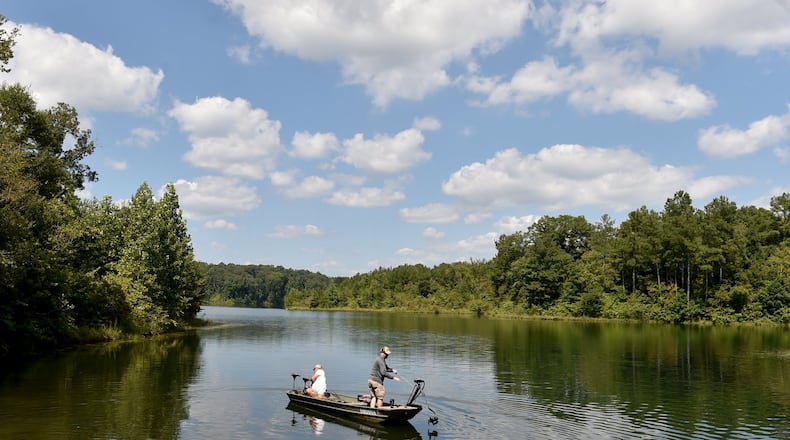New and sharply lower population estimates cloud the future of a proposed reservoir in Hall County, a prize project in Gov. Nathan Deal’s home county and a key part of his water policy.
Hall officials have been pursuing the 850-acre Glades reservoir for more than a decade based on the premise that they needed the water to deal with an expected population boom, and just two years ago Deal’s signature water program set aside millions in state funding to push the project along.
But new projections from the Governor’s Office of Planning and Budget show Hall County with only modest population growth of 318,828 by 2050 — less than half the 729,192 people that an earlier projection said were coming. If that figure is correct, Hall County likely has all the water it needs.
Local officials discount the new state figures, but admit growth has tapered.
“I’m not sure how much faith I put in that number,” said Hall County Commissioner Scott Gibbs said of the recent state figures. “Our growth seems to be steadily rising, so I’m not sure. I’m sure they have done their homework, but Gainesville had the largest year they have ever had on building permits.”
Another blow to Glades and other reservoir projects came Thursday when the Metropolitan North Georgia Water Planning District released forecasts estimating a 25 percent drop in water use by metro Atlanta residents by 2050. The district forecast notes that per capita water usage has dropped to 109 gallons per day. In their application, Hall County based their water needs on per capita water use of between 120 and 128.3 gallons per day.
State projections for growth in many of the state’s exurban counties have shrunk in recent years, but Hall’s expected growth has fallen more than most. For example, the state projects Forsyth County will grow from a little more than 200,000 today to 597,255 in 2050.
Opponents say the fact that Hall County continues to pursue the reservoir only underscores their belief that Glades is really an “amenity” lake — a place to build lake houses — rather than a true solution to regional water issues. Deal himself owns a home near the footprint of the proposed reservoir, although the home is currently on the market.
County Administrator Randy Knighton said the county has a “respectful disagreement” with the state over Hall’s expected growth.
“They are all projections, OK? We’re talking 35 years from now,” he said. “With the expanse of growth in metropolitan Atlanta, and the expectation of growth we have now? I think we will grow.”
So far, Hall County has spent $15 million on the project, mostly for consultants and lawyers.
Environmental groups opposed to Glades, and other pending reservoir projects around metro Atlanta, have seized on the new figures as ammunition for their argument that the project is environmentally and financially wasteful.
Last week, the Atlanta-based Southern Environmental Law Center filed fresh objections to Glades with the U.S. Army Corps of Engineers, which is tasked with issuing the needed federal permits for the new reservoir.
“The Corps has an obligation … to consider the most accurate and up-to-date information when evaluating a permit application,” wrote Gilbert Rogers, senior attorney with the law center.
Officials still back project
Reservoir construction was an early hallmark of Gov. Nathan Deal’s water policy. The governor pledged $300 million over four years for water supply projects, a fact which irked officials in Alabama and Florida who have spent more than a decade feuding with Georgia over water rights.
In 2013, the Governor’s Water Supply Program pledged $45 million in state money for Glades and three other reservoir projects. The Georgia Environmental Finance Authority (GEFA) is tasked with distributing the money, but Glades has yet to receive any of it. The initial cost of the reservoir was pegged at $130 million.
“We continue to work with Hall County on what the state’s role and investment will be in the project,” said GEFA spokesman Shane Hix. “We’re committed to the project.”
Deal’s office declined to comment on Glades or the new population figures, citing a gag order in place around the tri-state water talks.
David Swanson, a demographer and professor at the University of California Riverside, said it is hard to keep politics out of population projections when they are being used to allocate resources, like water. That’s a problem because projections are volatile, shifting with changing conditions.
“Usually it’s the smaller areas where you get the real noticeable effect,” he said.
So a suburban county, like Hall, can see larger swings in projected growth than a large city or an entire state, making planning difficult.
The Governor’s Office of Planning and Budget’s latest projections begin with a warning that planners should use them “with full awareness of the inherent limitations of population projections.” But the report outlines some broad post-recession trends that may effect the need for Glades and other reservoirs in Atlanta’s farther-flung suburbs.
First, migration and birth rates have both declined since the recession, the report states. Second, growth is concentrated in the big, urban counties.
“Fulton, Gwinnett and Cobb counties account for nearly 50 percent of the overall population growth of Georgia between 2010 and 2013,” the report found.
Dueling population projections
Given these trends, does Hall County need an 11.7 billion gallon reservoir? Not at all, said Juliette Cohen with the environmental group Chattahoochee Riverkeeper.
“If you take the county’s water demand projections per capita, you still have enough water to 2050 without the installation of Glades reservoir,” she said. “The growth that the whole county was projecting is not coming to fruition. Those numbers were high to start with. They were grossly over-projected.”
Swanson, who has worked with states in developing population projections, said local jurisdictions can counter disappointing projections by hiring a demographer and doing their own. That’s exactly what Hall did when state projections showed slower growth.
Hall’s homegrown report projects a 2050 population of 489,000, Knighton said. That’s 170,000 more people than the state projects.
The case for need is crucial for Hall, which is negotiating the maze of federal procedures required to receive a permit from the Corps. This fall, the Corps expects to hold hearings on a draft Environmental Impact Statement for Glades.
Gainesville Mayor Danny Dunagan, who supports building Glades, said he had not seen the latest state population projections. But he said Hall County officials have been working on the Glades reservoir for well more than a decade and it does not make sense to stop now.
“You can’t sit back and wait until the last minute. I think the reservoir is needed,” he said. “There are concerns about the cost. But if you run out of water, what price can you put on water?”
Gibbs, the Hall commissioner, thinks the county’s population will be somewhere around a half million by 2050, essentially pacing what the state projects for neighboring Forsyth County. Regardless, Gibbs said the county is growing, and considering how long reservoirs take to get approved and built, there is no percentage in turning back now.
“I can’t wait until 2050 to do the application,” he said. “Twenty years later I’ll still be waiting for a permit.”
About the Author
Keep Reading
The Latest
Featured




